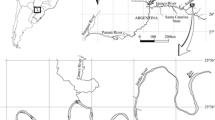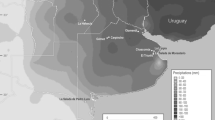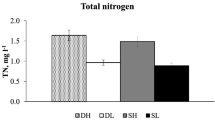Abstract
Dilute soda lakes are among the world’s most productive environments and are usually dominated by dense blooms of cyanobacteria. Up to now, there has been little information available on heterotrophic bacterial abundance, production, and their controlling factors in these ecosystems. In the present study the main environmental factors responsible for the control of the heterotrophic bacterial community in five shallow soda pools in Eastern Austria were investigated during an annual cycle. Extremely high cyanobacterial numbers and heterotrophic bacterial numbers up to 307 × 109 L−1 and 268 × 109 L−1 were found, respectively. Bacterial secondary production rates up to 738 µg C L−1 h−1 and specific growth rates up to 1.65 h−1 were recorded in summer and represent the highest reported values for natural aquatic ecosystems. The combination of dense phytoplankton blooms, high temperature, high turbidity, and nutrient concentration due to evaporation is supposed to enable the development of such extremely productive microbial populations. By principal component analysis containing the data set of all five investigated pools, two factors were extracted which explained 62.5% of the total variation of the systems. The first factor could be interpreted as a turbidity factor; the second was assigned to as concentration factor. From this it was deduced that bacterial and cyanobacterial abundance were mainly controlled by wind-induced sediment resuspension and turbidity stabilized by the high pH and salinity and less by evaporative concentration of salinity and dissolved organic carbon. Bacterial production was clustered with temperature in factor 3, showing that bacterial growth was mainly controlled by temperature. The concept of describing the turbid water columns of the shallow soda pools as “fluid sediment” is discussed.





Similar content being viewed by others
References
RM Autio (1992) ArticleTitleTemperature regulation of brackish water bacterioplankton. Ergebn Limnol 37 253–263
R Bachofen A Schenk (1998) ArticleTitleQuorum sensing autoinducers: Do they play a role in natural microbial habitats? Microbiol Res 153 61–63 Occurrence Handle1:CAS:528:DyaK1cXisFKls7o%3D
N Bano M-U Nisa N Khan M Saleem PJ Harrison SI Ahmed F Azam (1997) ArticleTitleSignificance of bacteria in the flux of organic matter in the tidal creeks of the mangrove ecosystems of the Indus River delta, Pakistan. Mar Ecol Prog Ser 157 1–12 Occurrence Handle1:CAS:528:DyaK2sXntFynurg%3D
BL Bassler (1999) ArticleTitleHow bacteria talk to each other: regulation of gene expression by quorum sensing. Curr Opin Micriobiol 2 582–587 Occurrence Handle1:CAS:528:DC%2BD3cXivF2jsA%3D%3D
PI Boon (1991) ArticleTitleBacterial assemblages in rivers and billabongs of southeastern Australia. Microb Ecol 22 27–52
AW Duckworth WD Grant BE Jones R van Steenbergen (1996) ArticleTitlePhylogenetic diversity of soda lake alkaliphiles. FEMS Microbiol Ecol 19 181–191
VP Evangelou (1998) Soil and Water Chemistry. John Wiley and Sons New York
H Fischer M Pusch (1999) ArticleTitleUse of the 14C leucine incorporation technique to measure bacterial production in river sediments and the epiphyton. Appl Environ Microbiol 65 4411–4418 Occurrence Handle1:CAS:528:DyaK1MXms1OisLo%3D Occurrence Handle10508068
CG Forsberg S-O Ryding (1980) ArticleTitleEutrophication parameters and trophic state indices in 30 Swedish waste-receiving lakes. Arch Hydrobiol 89 189–207 Occurrence Handle1:CAS:528:DyaL3MXnsVWm
JA Fuhrman F Azam (1982) ArticleTitleThymidine incorporation as a measure of heterotrophic bacterioplankton production in marine surface waters: evaluation and field results. Mar Biol 66 109–120
WD Grant BJ Tindall (1986) The alkaline, saline environment. RA Herbert GA Codd (Eds) Microbes in Extreme Environments. Academic Press London 22–54
WD Grant BE Jones WE Mwatha (1990) ArticleTitleAlkaliphiles: ecology, diversity and applications. FEMS Microbiol Rev 75 255–270 Occurrence Handle1:CAS:528:DyaK3cXkvFCnsb4%3D
WD Grant (1992) Alkaline environments. J Lederberg (Eds) Encyclopedia of Microbiology, vol 1. Academic Press San Diego 73–80
BE Jones WD Grant NC Collins WE Mwatha (1994) Alkaliphiles: diversity and identification. FG Priest A Ramos-Cormenzana BJ Tindall (Eds) Bacterial Diversity and Systematic. Plenum New York 195–229
N Kamjunke S Jähnichen (2000) ArticleTitleLeucine incorporation by Microcystis aeruginosa. Limnol Oceanogr 45 741–743 Occurrence Handle1:CAS:528:DC%2BD3cXjsV2lur8%3D
P Kilham (1981) ArticleTitlePelagic bacteria: extreme abundances in African saline lakes. Naturwissenschaften 68 380–381
D Kirchman H Ducklow R Mitchell (1982) ArticleTitleEstimates of bacterial growth from changes in uptake rates and biomass. Appl Environ Mirobiol 44 1296–1307 Occurrence Handle1:CAS:528:DyaL3sXhsFOmurw%3D
D Kirchman E K’Nees R Hodson (1985) ArticleTitleLeucine incorporation and its potential as a measure of protein synthesis by bacteria in natural aquatic systems. Appl Environ Microbiol 49 599–607 Occurrence Handle1:CAS:528:DyaL2MXhsVGru7k%3D Occurrence Handle3994368
AKT Kirschner B Velimirov (1997) ArticleTitleA seasonal study of bacterial community succession in a temperate backwater system, indicated by variation in morphotype numbers, biomass, and secondary production. Microb Ecol 34 27–38 Occurrence Handle9178603
AKT Kirschner B Velimirov (1999) ArticleTitleModification of the 3H-leucine centrifugation method for determining bacterial protein synthesis in freshwater samples. Aquat Microb Ecol 17 201–206
AKT Kirschner B Velimirov (1999) ArticleTitleBenthic bacterial secondary production measured via simultaneous 3H-thymidine and 14C-leucine incorporation, and its implication for the carbon cycle of a shallow macrophyte-dominated backwater system. Limnol Oceanogr 44 1871–1881 Occurrence Handle1:CAS:528:DC%2BD3cXhsFKktA%3D%3D
AL Koch (1980) ArticleTitleThe inefficiency of ribosomes functioning in Escherichia coli growing at moderate rates. J Gen Microbiol 116 165–171 Occurrence Handle1:STN:280:Bi%2BC287osFQ%3D Occurrence Handle6988541
J Komarek K Anagnostidis (1999) Granoprokaryota. H Ettl G Gärtner H Heywig F Mollenhauer (Eds) Süßwasserflora von Mitteleuropa. Gustav Fischer Jena
Ru Krachler Re Krachler E Milleret W Wesner (2000) ArticleTitleLimnochemische Untersuchungen zur aktuellen Situation der Salzlacken im burgenländischen Seewinkel. Burgenländische Heimatblätter 62 3–49
C Nilsson K Sundback (1996) ArticleTitleAmino acid uptake in natural microphytobenthic assemblages studied by microautoradiography. Hydrobiologia 332 119–129 Occurrence Handle1:CAS:528:DyaK28XnsV2kur4%3D
RT Noble JA Fuhrman (2000) ArticleTitleRapid virus production and removal as measured with fluorescently labeled viruses as tracers. Appl Environ Microbiol 66 3790–3797
S Norland (1993) The relationship between biomass and volume of bacteria. PF Kemp EB Sherr JJ Cole (Eds) Current Methods in Aquatic Microbial Ecology. Lewis Publishers Boca Raton, FL 303–307
EA Nusch (1980) ArticleTitleComparison of different methods for chlorophyll and phaeopigment determination. Arch Hydrobiol Beih Ergebn Limnol 14 14–36 Occurrence Handle1:CAS:528:DyaL3MXktVaru7o%3D
KG Porter YS Feig (1980) ArticleTitleThe use of DAPI for identifying and counting aquatic microflora. Limnol Oceanogr 25 943–948
M Revilla A Iriarte I Madariaga E Orive (2000) ArticleTitleBacterial and phytoplankton dynamics along a trophic gradient in a shallow temperate estuary. Est Coast Shelf Sci 50 297–313
RD Robarts MT Arts MS Evans MJ Waiser (1994) ArticleTitleThe coupling of heterotrophic bacterial and phytoplankton production in a hypertrophic shallow prairie lake. Can J Fish Aquat Sci 51 2219–2226
BC Sander J Kalff (1993) ArticleTitleFactors controlling bacterial production in marine and freshwater sediments. Microb Ecol 26 79–99
F-K Shiah HW Ducklow (1995) ArticleTitleMultiscale variability in bacterioplankton abundance, production, and specific growth rate in a temperate salt-marsh tidal creek. Limnol Oceanogr 40 55–66 Occurrence Handle1:CAS:528:DyaK2MXmtFaitb4%3D
M Simon F Azam (1989) ArticleTitleProtein content and protein synthesis rates of planktonic marine bacteria. Mar Ecol Prog Ser 51 201–213 Occurrence Handle1:CAS:528:DyaL1MXhvV2jsL8%3D
JD Strickland TR Parsons (1968) ArticleTitleA practical handbook of seawater analysis. Bull Fish Res Board Can 167
E Törnblom B Boström (1995) ArticleTitleBenthic microbial response to a sedimentation event at low temperature in sediments of a eutrophic lake. Mar Freshwater Res 46 33–43
HJ Voigt (1990) Hydrogeochemie. Springer Verlag Berlin
PA White J Kalff JB Rasmussen JM Gasol (1991) ArticleTitleThe effect of temperature and algal biomass on bacterial production and specific growth rate in freshwater and marine habitats. Microb Ecol 21 99–118 Occurrence Handle2360901
JH Zar (1974) Biostatistical Analysis. Prentice Hall Englewood Cliffs, NJ
GA Zavarzin (1993) ArticleTitleEpicontinental soda lakes as probable relict biotopes of terrestial biota formation. Microbiology 62 473–479
JP Zehr RW Harvey RS Oremland JE Cloern LH George JL Lane (1987) ArticleTitleBig Soda Lake (Nevada) 1. Pelagic bacterial heterotrophy and biomass. Limnol Oceanogr 32 781–793 Occurrence Handle1:CAS:528:DyaL2sXmt1aktbg%3D
GM Zinabu WD Taylor (1997) ArticleTitleBacteria–chlorophyll relationships in Ethiopian lakes of varying salinity: are soda lakes different? J Plankton Res 19 647–654
Acknowledgements
Special thanks are due to Monika Bright and Christian Rinke (Institute of Marine Biology, University of Vienna) for providing all facilities for microautoradiographic studies and to Mr. Rauchwarter (Biological Research Institute, Illmitz) for the measurement of chlorophyll a, DOC, and suspended solids. Additional thanks to Lars Tranvik (University of Uppsala, Department of Limnology), Jon Zehr (University of California, Santa Cruz, Department of Ocean Sciences), and three anonymous reviewers for valuable comments on an earlier version of the manuscript. The study was financed by a grant of the national park Neusiedlersee—Seewinkel (NP-24; Dir. Kirchberger).
Author information
Authors and Affiliations
Corresponding author
Rights and permissions
About this article
Cite this article
Eiler, A., Farnleitner, A., Zechmeister, T. et al. Factors Controlling Extremely Productive Heterotrophic Bacterial Communities in Shallow Soda Pools . Microb Ecol 46, 43–54 (2003). https://doi.org/10.1007/s00248-002-2041-9
Received:
Accepted:
Published:
Issue Date:
DOI: https://doi.org/10.1007/s00248-002-2041-9




